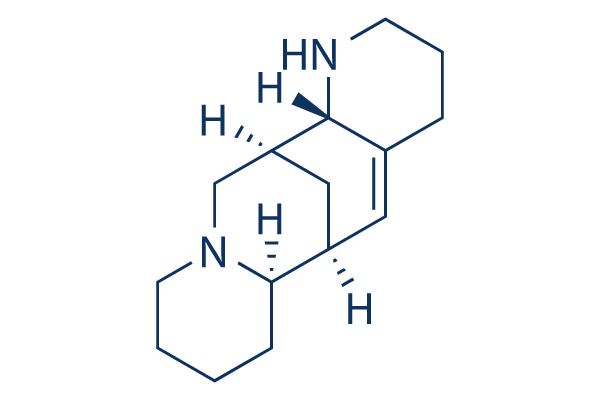|
受注:045-509-1970 |
技術サポート:[email protected] 平日9:00〜18:00 1営業日以内にご連絡を差し上げます |
化学情報

|
Synonyms | N/A | Storage (From the date of receipt) |
3 years -20°C powder 1 years -80°C in solvent |
| 化学式 | C15H24N2 |
|||
| 分子量 | 232.36 | CAS No. | 56293-29-9 | |
| Solubility (25°C)* | 体外 | DMSO | 46 mg/mL (197.96 mM) | |
| Ethanol | 46 mg/mL warmed with 50ºC water bath (197.96 mM) | |||
| Water | 4 mg/mL (17.21 mM) | |||
|
* <1 mg/ml means slightly soluble or insoluble. * Please note that Selleck tests the solubility of all compounds in-house, and the actual solubility may differ slightly from published values. This is normal and is due to slight batch-to-batch variations. |
||||
溶剤液(一定の濃度)を調合する
生物活性
| 製品説明 | Aloperine is an isolated alkaloid in sophora plants such as Sophora alopecuroides L, and exhibits anti-inflammatory, antibacterial, antiviral, and anti-tumor properties. |
|---|---|
| in vitro | Compared with other alkaloids including sophoridine, sophocarpine, matrine, oxymatrine and cytisine, Aloperine treatment exerts the most potent cytotoxic activity against human cancer cell lines of differing tissue origins, including leukaemia cell lines HL-60, U937 and K562, oesophageal cancer EC109 cells, lung cancer A549 cells and the hepatocellular carcinoma HepG2 cell line with IC50 of 0.04 mM, 0.27 mM, 0.36 mM, 1.11 mM, 1.18 mM, and 1.36 mM, respectively. The strongest cytotoxic effect of Aloperine on HL-60 cells is observed at 72 hours with the inhibition rate of 94.1%.In contrast to the effect on leukaemia cells, up to 1 mM of Aloperine does not significantly reduce the viability of normal PBMNCs at 72 hours. Aloperine treatment at 20 μM for 48 hours significanlty induces apoptosis and autophagy in HL-60 cells in a dose-dependent manner. [2] |
| in vivo | Topical application of 1% Aloperine suppresses 2, 4-dinitrofluorobenzene (DNFB)-induced increase in ear thickness and ear erythema in BALB/c mice, and significantly decreases the up-regulated mRNA and protein levels of tumor necrosis factor-alpha (TNF-α), interleukin-1beta (IL-1β) and interleukin-6 (IL-6) induced by DNFB in ear biopsy homogenates. [1] Topical application of Aloperine reduces the DNFB-induced dermatitis (dermatitis index and ear thickness) in NC/Nga mice at day 13 and day 14 in a dose-dependent manner. Aloperine treatment reduces DNFB-induced lymphocytes infiltration and eosinophils infiltration in a dose-dependent manner. Aloperine treatment also reduces the DNFB-induced infiltration of mast cells in a dose-dependent manner. Aloperine reduces the plasma level of IgE in a dose-dependent manner. Aloperine markedly reduces DNFB-induced increase in IL-4, IL-13 and IFN-γ productions, while it increases the IL-10 level in a dose-dependent manner. Aloperine treatment significantly reduces the cytokine levels of TNF-α, IL-1β and IL-6 in ear biopsies homegenates of NC/Nga mice in a dose-dependent manner. [3] |
プロトコル(参考用のみ)
| 細胞アッセイ | 細胞株 | K562, U937, HL-60, EC109, A549 and HepG2 |
|---|---|---|
| 濃度 | Dissolved in DMSO, final concentrations ~2 mM | |
| 反応時間 | 24, 48, and 72 hours | |
| 実験の流れ | Cells are seeded in 96-well plates in 100-μL culture medium. After incubation of 4 hours for leukaemia cells and of 24 hours for solid cancer cells, experimental media containing either excipient control or Aloperine are added to appropriate wells. Five concentrations of Aloperine for 48-hour treatment are used to determine the in vitro IC50 growth inhibitory values of Aloperine in cancer cells. After incubation, 10 μL of MTT solution (5 mg/mL) is added to each well. The plates are then incubated for 4 hours at 37 °C. Intracellular formazan crystals are dissolved by addition of 100 μL of isopropanol-HCI-SDS solution to each well. After an overnight incubation at 37 °C, the optical density of the samples is determined at 570 nm. DNA fragmentation is analysed after the extraction of DNA from cells exposed to the indicated doses of Aloperine for 48 hours using apoptotic DNA ladder kit. For autophagy detection, cells are collected and incubated with PBS containing 5 μM acridine orange for 15 minutes. The acridine orange is removed and the cells are resuspended in 100 μL of PBS. Fluorescent micrographs are obtained with an inverted fluorescent microscope. Autophagy is quantified based on the mean number of cells displaying intense red staining for three fields (containing at least 50 cells per field) for each experimental condition. | |
| 動物実験 | 動物モデル | Female BALB/c mice with DNFB-induced allergic contact dermatitis |
| 投薬量 | 1% (w/w) | |
| 投与方法 | Topical application |
参考
|
Selleckの高級品が、幾つかの出版された研究調査結果(以下を含む)で使われた:
| Aloperine inhibits the progression of non-small-cell lung cancer through the PI3K/Akt signaling pathway [ Cancer Cell Int, 2021, 21(1):662] | PubMed: 34895234 |
| Aloperine inhibits colorectal cancer cell proliferation and metastasis progress via regulating miR-296-5p/STAT3 axis [ Tissue Cell, 2021, 74:101706] | PubMed: 34883316 |
| Aloperine in combination with therapeutic adenoviral vector synergistically suppressed the growth of non-small cell lung cancer. [ J Cancer Res Clin Oncol, 2020, 10.1007/s00432-020-03157-2] | PubMed: 32088783 |
| Autophagy Modulation in Human Thyroid Cancer Cells following Aloperine Treatment [ Int J Mol Sci, 2019, 20(21)E5315] | PubMed: 31731481 |
| Identification of Aloperine as an anti-apoptotic Bcl2 protein inhibitor in glioma cells. [ PeerJ, 2019, 7:e7652] | PubMed: 31534865 |
| In Vitro Antitumor Activity of Aloperine on Human Thyroid Cancer Cells through Caspase-Dependent Apoptosis [ Int J Mol Sci, 2018, 19(1)E312] | PubMed: 29361731 |
| Aloperine executes antitumor effects through the induction of apoptosis and cell cycle arrest in prostate cancer in vitro and in vivo. [ Onco Targets Ther, 2018, 11:2735-2743] | PubMed: 29785122 |
長期の保管のために-20°Cの下で製品を保ってください。
人間や獣医の診断であるか治療的な使用のためにでない。
各々の製品のための特定の保管と取扱い情報は、製品データシートの上で示されます。大部分のSelleck製品は、推薦された状況の下で安定です。製品は、推薦された保管温度と異なる温度で、時々出荷されます。長期の保管のために必要とされてそれと異なる温度で、多くの製品は、短期もので安定です。品質を維持するが、夜通しの積荷のために最も経済的な貯蔵状況を用いてあなたの送料を保存する状況の下に、製品が出荷されることを、我々は確実とします。製品の受領と同時に、製品データシートの上で貯蔵推薦に従ってください。
